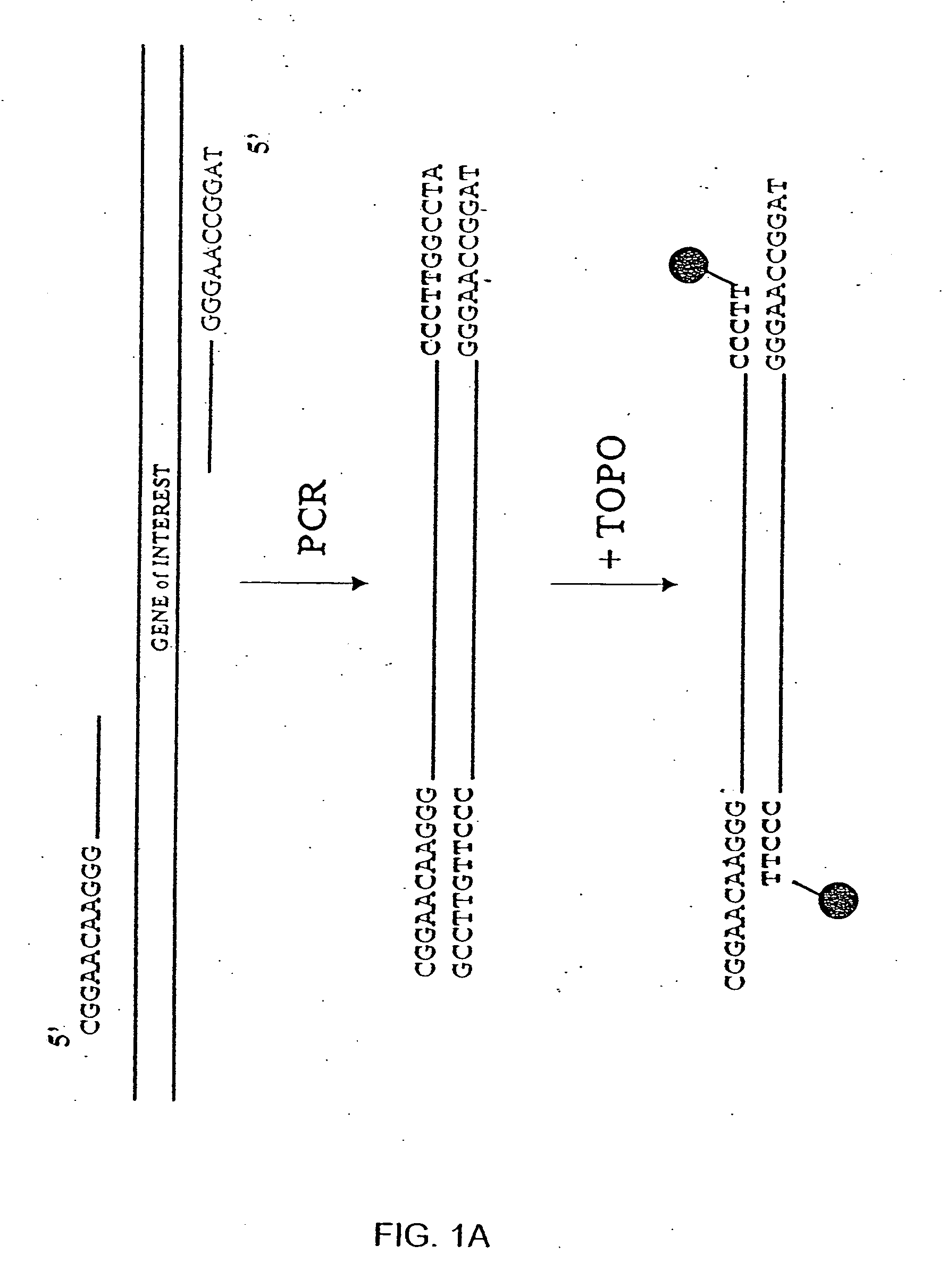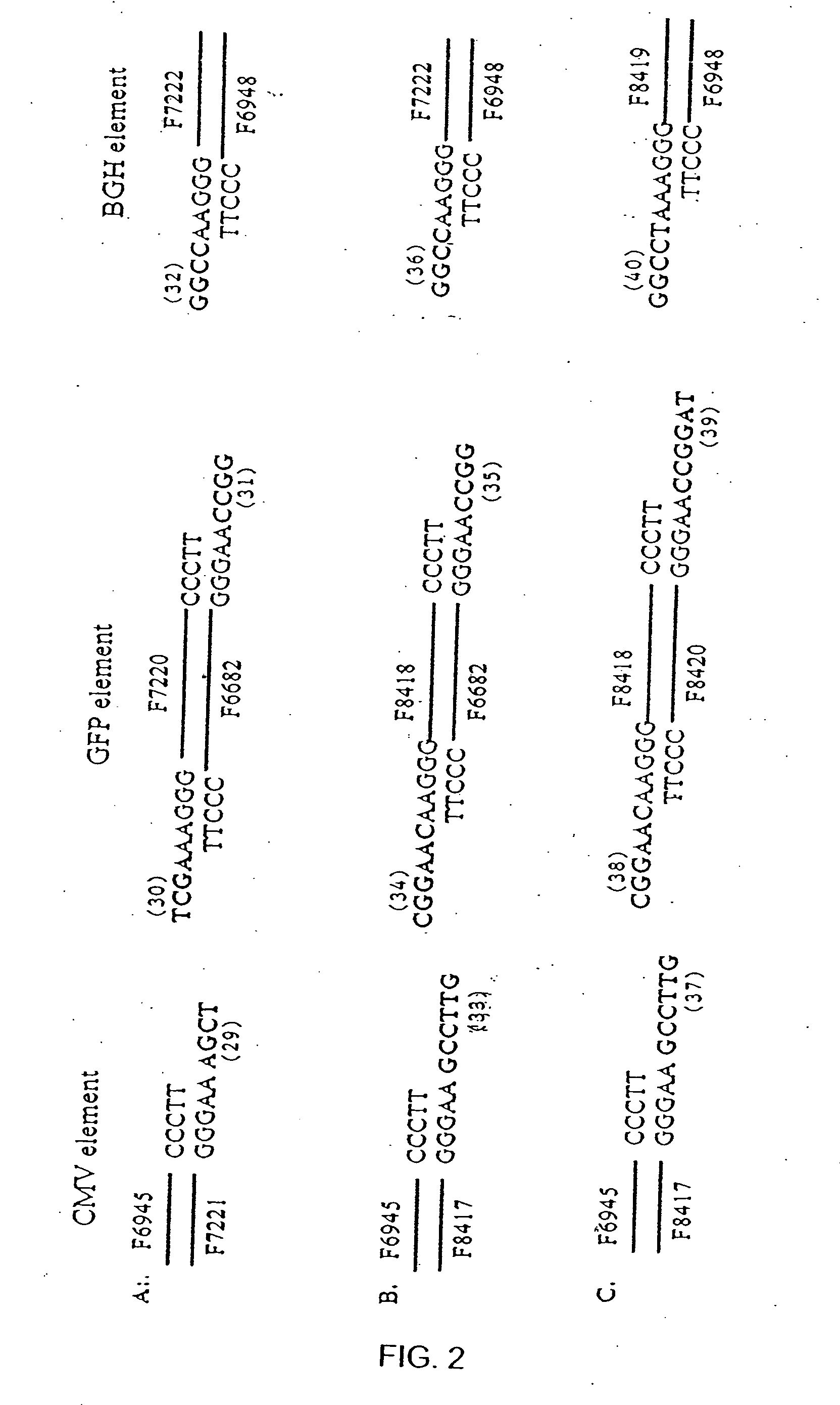Methods and compositions for generating recombinant nucleic acid molecules
a nucleic acid and molecule technology, applied in the field of methods and compositions for generating recombinant nucleic acid molecules, can solve the problems of the inability to bind to the nick, and the inability to ensure the stability of the nick,
- Summary
- Abstract
- Description
- Claims
- Application Information
AI Technical Summary
Benefits of technology
Problems solved by technology
Method used
Image
Examples
example 1
Construction of Covalently Linked Double Stranded Recombinant Nucleic Acid Molecules Using Topoisomerase
[0275] This experiment demonstrates that topoisomerase can be used to produce covalently linked double stranded (ds) recombinant nucleic acid molecules.
A. Methods
[0276] Except where indicated, experiments were performed using the following methods. PCR was performed in 50 Tl reactions, including 10 ng plasmid (template), 100 ng each primer, 2.5 Units Taq DNA polymerase (Sigma), 5 Tl 10×PCR buffer, and 4 Tl of dNTPs (200 TM each). An initial denaturation was performed by incubating the reaction at 94° C. for 4 min; followed by 30 cycles of PCR using 94° C. (45 sec) for denaturation, 55° C. (45 sec) for primer annealing and 72° C. (1 min per kb of target sequence) for extension. After cycling, the reactions were incubated at 72° C. (10 min), and then placed at 4° C.
[0277] Topoisomerase joining reactions were performed in 5 Tl, including 50-100 ng each amplified element (PCR-gen...
example 2
Functional Characterization of Topoisomerase-Generated DS Recombinant Nucleic Acid Molecules
[0282] This example demonstrates that a method of the invention provides a means to generate functional ds recombinant nucleic acid molecules covalently linked in both strands.
A. Expression of Sense and Antisense mRNA from a Topo-ligated Construct
[0283] The ability to create a ds recombinant nucleic acid molecule containing functional upstream and downstream elements flanking a gene of interest was examined using two synthetic elements containing either a T7 or a T3 promoter sequence. The elements were made by annealing pairs of synthetic oligonucleotides. The T7 linker was generated by mixing equal molar amounts of T7top (F9304; SEQ ID NO: 20) and T7bottom (F9305; SEQ ID NO: 21) oligonucleotides (Table 1). The T3 linker was generated by mixing equal molar amounts of T3top (F9661; SEQ ID NO: 23) and T7bottom (F9662; SEQ ID NO: 24) oligonucleotides (Table 1). The mixtures were heated in bo...
example 3
Generation, Purification, and Transfection of Gene-Specific d-siRNA and TOPO-Mediated Generation of Templates and Production of Double-Stranded RNA for Use in RNA Interference Analysis
[0292] Exemplary product literature is provided below that describes the generation, purification, and transfection of gene-specific d-siRNA for use in RNA interference analysis, TOPO-mediated generation of templates and production of double-stranded RNA for use in RNA interference analysis. All catalog numbers provided below correspond to Invitrogen Corporation products, Carlsbad, Calif., unless otherwise noted. See also U.S. Ser. No. 10 / 902,704, entitled “Compositions and Methods for Preparing Short RNA Molecules and Other Nucleic Acids,” filed Jul. 30, 2004, which is incorporated herein by reference.
[0293] D-siRNA Generation and Transfection Procedure
[0294] Produce dsRNA
[0295] Follow the guidelines to generate dsRNA. If you are using the BLOCK-iT™ Complete Dicer RNAi Kit, refer to the BLOCK-iT™ ...
PUM
 Login to View More
Login to View More Abstract
Description
Claims
Application Information
 Login to View More
Login to View More - R&D
- Intellectual Property
- Life Sciences
- Materials
- Tech Scout
- Unparalleled Data Quality
- Higher Quality Content
- 60% Fewer Hallucinations
Browse by: Latest US Patents, China's latest patents, Technical Efficacy Thesaurus, Application Domain, Technology Topic, Popular Technical Reports.
© 2025 PatSnap. All rights reserved.Legal|Privacy policy|Modern Slavery Act Transparency Statement|Sitemap|About US| Contact US: help@patsnap.com



